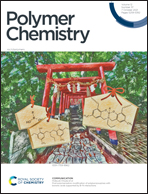Synthesis and characterization of amide-bridged colorless polyimide films with low CTE and high optical performance for flexible OLED displays†
Abstract
Three novel dianhydride monomers involving amide groups were synthesized and further polymerized with various diamines to afford a series of colorless polyimides (cPI). The resultant cPI films present outstanding optical performance, exceedingly good dimensional stability at high temperature, great film ductility and solution-processability. In particular, chemically imidized AMDA/TFDB has an ultra-low coefficient of thermal expansion value of 5.2 ppm K−A, a relatively high Tg value of 333 °C and large elongation at break of 29%, resulting from its rigid-rod backbone and the formation of hydrogen bonding (–C![[double bond, length as m-dash]](https://www.rsc.org/images/entities/char_e001.gif) O⋯NH–) between adjacent molecular chains. Concurrently, it exhibits a high optical transmittance of 87% at a wavelength of 550 nm, a small haze value of 0.71 and low yellow index of 4.29 by reason that the incorporation of bulky trifluoromethyl and cyclohexyl preclude the formation of a charge transfer complex effectively. The high overall performance of the amide-containing cPI films suggests its potential application in the field of flexible OLED displays.
O⋯NH–) between adjacent molecular chains. Concurrently, it exhibits a high optical transmittance of 87% at a wavelength of 550 nm, a small haze value of 0.71 and low yellow index of 4.29 by reason that the incorporation of bulky trifluoromethyl and cyclohexyl preclude the formation of a charge transfer complex effectively. The high overall performance of the amide-containing cPI films suggests its potential application in the field of flexible OLED displays.



 Please wait while we load your content...
Please wait while we load your content...